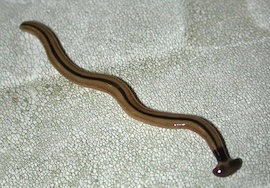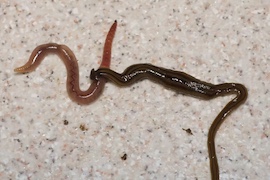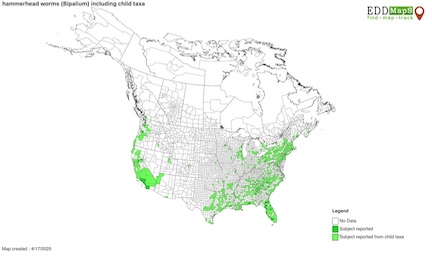Hammerhead Worm

| |
| Kingdom: | Animalia |
|---|---|
| Phylum: | Platyhelminthes |
| Class: | Turbellaria |
| Order: | Tricladida |
| Family: | Geoplanidae |
| Genus: | Bipalium |
| Source: County of Brant [4] | |
Description
Bipalium, also known as the hammerhead worm, land planarian, or shovel-head garden worm, is a genus of invasive flatworm found in moist terrestrial environments in the northeastern United States [2]. The hammerhead worm is native to Southeast Asia and was introduced in 1891 [1]. This is easily identifiable by its distinct flattened body and crescent-shaped head. The worms are most often yellow, orange, or light brown, with a varying number of darker brown stripes running the length of the body [2]. Hammerhead worms pose a threat to natural ecosystems, as there are at least three species that have been found to feed exclusively on earthworms. They also pose a potential threat to agricultural operations, especially those operating in warm, moist environments [3].

Behaviors
Habitat and Range
Hammerhead flatworms thrive in moist environments, including forests and agricultural fields. They are found amongst the upper soil layers and in leaf litter [2]. Although these worms prefer warm, wet environments, they are highly adaptive to different environments, including temperate forests in midlatitudes. This element allows hammerhead worms to invade higher latitudes than those to which they are native. In their native range of Southeast Asia, hammerhead flatworms live in soils.
Life Cycle
The hammerhead worm is hermaphroditic like most terrestrial worms, however they also have the ability to reproduce asexually via binary fission [7]. This allows Bipalium to reproduce quickly in stressful environments, and also contributes to their ability to invade new areas across the United States [8].
Impact as an Invasive Species

Hammerhead worms disrupt the natural soil ecosystem the occurs below the leaf litter in forest and agricultural environments. The worms mainly consume earthworms and other soil macroinvertebrates, which has negetive effects on the lower trophic levels of organisms in the soil.
Bipalium has the ability to reproduce through binary fission. This means that a single worm can spontaneously split into two, and each half will regrow the missing half in approximately a week.
There is potential for invasive hammerhead flatworms to have natural predators in the Northeastern United States. Carnivorous snails have been shown to have positive impacts on decreasing bipalium populations in a lab setting. With more research, there is potential for these snail species to help reduce populations.
References
[1] Ducey, P. K., J. Cerqua, L.-J. West, and M. Warner. 2006. Rare Egg Capsule Production in the Invasive Terrestrial Planarian Bipalium kewense on JSTOR.
[2] Skvarla, M. J. 2022, May 2. Hammerhead Flatworms and Other Land Planaria of Eastern North America. https://extension.psu.edu/hammerhead-flatworms-and-other-land-planaria-of-eastern-north-america.
[3] Canello, R., V. S. Lemos, and Leal-Zanchet. 2012. Carnivore mollusks as natural enemies of invasive land flatworms - Lemos - 2012 - Annals of Applied Biology - Wiley Online Library.
[4] County of Brant. 2024, April 30. Hammerhead Worm. https://www.brant.ca/en/recreation-and-parks/hammerhead-worm.aspx.
[5] Jones, H., and J.-L. Justine. 2020, November 9. Land flatworms are invading the West Indies. http://theconversation.com/land-flatworms-are-invading-the-west-indies-149691.
[6] EDDMapS. 2025. Early Detection & Distribution Mapping System. The University of Georgia - Center for Invasive Species and Ecosystem Health. Available online at http://www.eddmaps.org/; last accessed April 17, 2025.
[7] Ducey, P. K., L.-J. West, G. Shaw, and J. De Lisle. 2005. Reproductive ecology and evolution in the invasive terrestrial planarian Bipalium adventitium across North America. Pedobiologia 49:367–377.
[8] Ogren, R. E., and J. K. Sheldon. 1991. Ecological Observations on the Land Planarian Bipalium Pennsylvanicum Ogren, with References to Phenology, Reproduction, Growth Rate and Food Niche. Journal of the Pennsylvania Academy of Science 65:3–9.